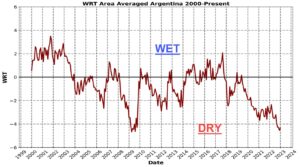Dehydration can often have a lot of aftereffects, from fatigue to nausea and more. And while most of us are used to drinking enough water throughout the day, what we’re experiencing on a global level is a bit different.
Using data from the Water Risk Tracker and analyzing drought conditions in the prime agricultural belt in Argentina, for example, the current drought level is the most severe since 2000. In fact, during the past 23 years, the only two periods with drought conditions this severe were this summer and the summer of 2009.

Climate change has shifted weather patterns around the world, with varying consequences. Flowers near you are likely blooming earlier, signaling an early start to spring, and the weather has gotten more extreme in all seasons. Changing precipitation patterns along with increased demand for the commodity mean that water shortages will soon be a regular complication for businesses around the world—even yours.
Business drought risk is rising
Water use is critical somewhere in your supply chain. Even if your business isn’t feeling a water shortage right now, one of your direct suppliers, or one of theirs, is likely already a little dehydrated. If you aren’t already, you’ll soon start to feel the results.
For example, one of your suppliers may rely heavily on water for manufacturing. The current semiconductor chip shortage, for example, was largely caused by a drought in Taiwan and had ramifications across many different industries. Everything from appliance producers to car manufacturers to video game creators had to either adapt or wait to survive the chip shortage.
Or the impact of a water shortage could be felt further up your supply chain. Even if your top-tier suppliers aren’t affected by drought, their suppliers may be facing issues. Extracting raw materials can be a water-intensive process, and these manufacturers often supply multiple industries that will be competing against each other during a shortage.
Even if neither of these scenarios apply to your business yet, water shortages also directly affect shipping. Loaded barges have increasing trouble navigating waterways with a decreased flow, causing supply chain delays. So, a drought halfway around the world could be the reason for a delay in a shipment to you or a client.
How to mitigate drought risk
Don’t be caught off-guard by water shortages—it’s a trend that’s here to stay. But, even if you don’t have control over climate events, you can be in control of your management tactics. Stay ahead of any drought effects by making sure you have visibility into water risks throughout your entire supply chain.
Armed with accurate risk forecasting and predictive analysis, your business can take the necessary steps to dodge the side effects of drought and other water risks.